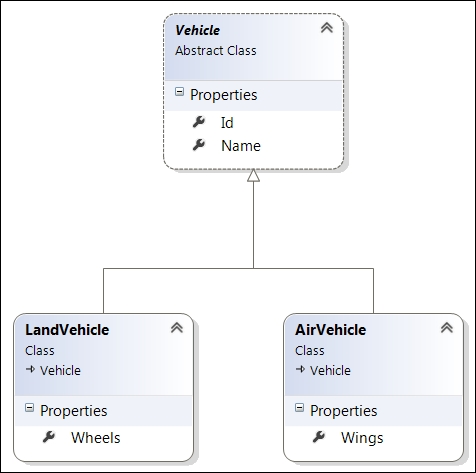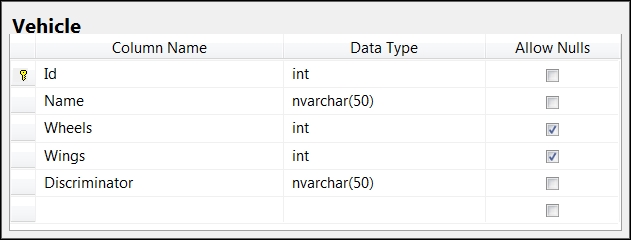Table per class hierarchy requires nullable columns for derived classes
When persisting class hierarchies, all properties in derived classes must be nullable.
Problem
A common pattern for representing class hierarchies in relational databases is to use a table that will have columns for each of the base and derived classes. For example, imagine we have a Vehicle base class and two derived classes, LandVehicle and AirVehicle:

Vehicles class model
Using the Table per class hierarchy (also called single table inheritance), this could be represented as follows:

Table per class hierarchy mapping table
You may have noticed that the columns that correspond to the properties in the derived classes–Wheels and Wings–are set to accept nulls. Why is that? Well, since this table has to support a schema for all the possible derived classes, we never know, for each row, which class it will map to. For that reason, all columns that correspond to the properties in derived classes need to be nullable, because otherwise, what value would we store there for the records that correspond to other classes?
Consider the following table per class hierarchy values for example:
|
ID |
Name |
Wheels |
Wings |
Discriminator |
|---|---|---|---|---|
|
1 |
Helicopter |
NULL |
0 |
|
|
2 |
Car |
4 |
NULL |
|
How to solve it…
All our properties of value types need to be marked as nullable:
public class LandVehicle : Vehicle
{
public int? Wheels { get; set; }
}
public class AirVehicle
{
public int? Wings { get; set; }
}This is for nullable value types; since they cannot be null, the built-in conventions will mark the properties as nullable. For reference types, we need to mark them as such explicitly, in the OnModelCreating method:
protected override void OnModelCreating(
protected override void OnModelCreating(
DbModelBuilder modelBuilder)
{
//create the hierarchy
modelBuilder
.Entity<Vehicle>()
.HasDiscriminator()
.HasValue<LandVehicle>(typeof(LandVehicle).Name)
.HasValue<AirVehicle>(typeof(AirVehicle).Name);
//mark Wheels as nullable – not required
modelBuilder
.Entity<Vehicle>()
.Property(x => x.Wheels)
.IsRequired(false);
//mark Wings as nullable – not required
modelBuilder
.Entity<AirVehicle>()
.Property(x => x.Wings)
.IsRequired(false);
base.OnModelCreating(modelBuilder);
}Here we are configuring the class Vehicle to have two derived classes, AirVehicle and LandVehicle, each using as its discriminator value, its own class name. Each property in one of the derived classes is set to not required (nullable).































































